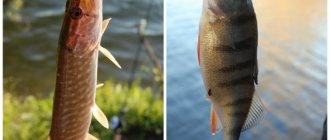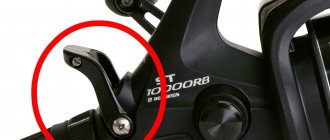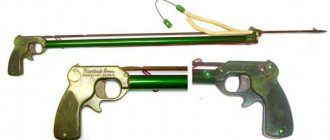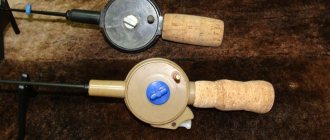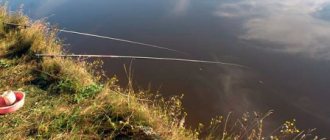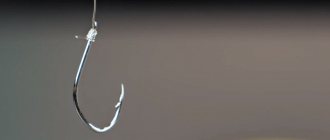Homemade hook.
I have long set out to make a hook that would be lightweight and fit into a winter box. Before that, there were long hooks - you had to fasten them to a drill, which is not very convenient. Buying from a store is also not an option - you would have to shorten them - why bother with unnecessary movements. I've had them lying around for a long time telescopic stands for fishing rods - that's what you need - I looked in the bins - I found handles and tubes and everything I needed for making - half a day and two hooks are ready. And now, in order:
I need a telescopic stand for a fishing rod - the handle can be made from any wood -or other dense material by drilling a hole along the diameter of the tube.
We bend the hook from a motorcycle knitting needle or elastic wire. I used the handle from an old spinning rod, having previously adjusted the hole to the diameter of the tube. Next, we cut everything to the required size
We drill a hole in the plug and pass the cord through, after placing the cambric inside, we knit it into a knot and burn it a little, then we put the plug on the handle with glue.
Next, we fix the hook in the retractable tube and the hook is ready.
When folded, the length is 45 cm, when unfolded it is up to 80 cm - you can set the length within these limits to whatever you need - the screw securely fixes it.
I still have a short part of the tube left from the stand - I found a suitable tube for it from an old pendant lamp and a handle from a soldering iron - it would be a sin not to make another hook - smaller - so that it would fit into a small box. I drove one part of the tube with threads and holes for the wires into the handle and placed it on the glue - I drilled the blind clamping plug through the diameter of the retractable tube and on the side, after tightening it, I drilled a hole for the M4 thread
The cork from a bottle of valerian fit perfectly under the cord; I placed it on liquid nails in the handle.
And then we refine the hooks - as best we can and everything is done. It took me about an hour to make the first one. The second one, taking into account the selection of materials, took a little more. I checked all the connections for rupture, but it was not possible to pull them out.
And be sure to make plugs on the tip from a thick-walled rubber tube.
You can use it even for winter fishing or summer fishing - it fits perfectly in any bag and does not take up much space. The weight is small 145 grams - which is larger than 200 grams, which is not particularly noticeable.
The hook is indispensable when fishing from a steep bank - you can drag it onto a flat bank. But this cannot be done on a step. Carrying a landing net with you is cumbersome and inconvenient - and the hook can be brought into working condition in a second and the trophy will not set sail to its native element.
Well, the price of the issue is 70 rubles for a stand + a minimum of hassle versus more than 400 for a store-bought one.
Description and purpose of the device
When fishing in open water, large fish are traditionally caught in a landing net. However, this method is simply not applicable for winter fishing. And there is nothing worse for an angler than dragging a fish to the ice and then not knowing what to do. It is not always possible to get a large specimen into a hole right away, and reaching into cold water with your hand is not an option, especially if there is a heavy pike on the hook, the teeth of which can seriously injure you. It’s good if there are fishermen nearby who will help. If you are alone with a fish, only a hook will help you out.
The design of a hook for winter fishing is very simple. Traditionally it consists of two parts:
- working part;
- lever.
The traditional material for making the working part is steel wire or tube. The handle is usually made of hard wood: beech, ash, birch. The surface of the wood is carefully sanded, impregnated with a water-repellent compound and painted dark for better contrast with the snow. It is not recommended to make metal handles; this makes the structure heavier and is not very comfortable in the cold.
Making the handle
Handles for hooks can be made not only from wood.
For this, it is quite possible to adapt a plastic handle from an old fishing rod. The main thing is to securely fix the working part in it. This can be done by simply threading the wire through the handle and bending the wire from which the hook is made. The bend can be recessed or hidden inside the handle, you can use glue or threaded fasteners - there are a lot of options. The lightest handles are made from cork. This is quite a suitable material for making a pen. You will need several wine corks, you can even use corks of different sizes, this will give the handle some curvaceousness. All of them are drilled through and put on the wire, after which the wire is bent and recessed in the outer plug. All elements are fixed together with instant glue.
In the same way, you can use not only cork, but also fine-pored foam. You just need to remember that the glue may contain a solvent that can melt the foam. Therefore, you first need to carry out a test gluing. Designs with porous handles are also preferable because if the hook jumps out of your hands, it will not sink. Although before use it is better to conduct a buoyancy test at home.
Working part
The working part with the hook is the basis of the hook. She may be:
- non-removable;
- collapsible;
- telescopic;
- folding.
The easiest way is to make a fish pot with a non-separable working part. Essentially, it is just a piece of thick steel wire, bent with a hook and sharpened on one side and with a handle on the other. Such a device is very simple to make, but its fixed length is not always convenient. Ice on reservoirs in the middle zone can reach a meter thick, and carrying such a long tool is very inconvenient.
The collapsible working part makes the hook more convenient. It is usually made of two halves. The lower part is made of thick steel wire. One end of it is bent in the form of a hook and sharpened, and a thread is made at the other end. The upper part with the handle can be made of the same wire, or from a tube. The wire is threaded with the same thread as on the lower part, and both halves are connected with a threaded coupling.
If the upper part is made of a tube, then an internal thread is cut in the lower part, and the second half with a hook is simply screwed into the first. This design has its advantages over the non-separable design, since it is twice as compact. The disadvantages include the need to constantly check the tightness of the threaded connection and the risk of losing the coupling.
Read: Catching perch on a balance beam in winter
The telescopic hook is the most convenient. You can also make it yourself, using an old car antenna as a basis. To make it you will also need:
- hook for catfish;
- several identical wine corks;
- instant glue;
- drill;
- soldering iron
The hook must be soldered into the thinnest elbow of the antenna. It is preferable not to use a fishing hook, but to bend it from ordinary steel wire of a suitable diameter. On the other side of the antenna, several plugs are placed on its thickest elbow, in which through holes are made along its length with a diameter slightly less than the thickness of the antenna. By putting the plugs on one after another, the entire structure is fixed with instant glue. When folded, such a hook is very compact and light in weight. When stretched, it can withstand very heavy loads, but when subjected to lateral force, it easily crushes and breaks.
Purpose of the hook
The good thing about the hook is that both in the finished and assembled state it is smaller than a landing net. Among other things, in this case there is no limit on the maximum size of the fish. But if you do catch-and-release fishing, this option is not suitable for you. The summer hook is about 1.5 meters long. If you are fishing by wading, it is better to choose a shorter option.
Bagoriks used in winter are shorter. In winter, there is no alternative to the product; landing nets cannot be inserted into the hole. And a do-it-yourself hook will make fishing convenient.
Separately, it is worth highlighting products intended for white fish. They have a lighter design. The presented version is very short. It is needed in order to pull out the fish when it is in close proximity to the hole. The handle should provide positive buoyancy.
The division of gaffs into summer and winter can be called conditional. In fact, any product can be used at any time. Also, hooks can be solid or include a number of elements.
Hook for fishing: purpose, types, making your own
To use a hook when fishing and not miss your catch, you need to follow simple rules:
- The prey must be pulled as close to the hole as possible;
- Dip the hook into water;
- Pull the fish head out of the water a little;
- Use a hook to grab the prey by the heat;
- Bring the fish to the surface.
With a seemingly large selection of fishing gear and various devices, specialized stores cannot boast of a large number of good fishing hooks. All of them are either not strong enough or simply inconvenient.
And some fishermen are even of the opinion that the gaff should be exclusively homemade. Many even say that it can bring good luck. And making a gaff with your own hands will not be difficult.
To make a fishing hook you will need wire about five millimeters thick. The easiest way to make a gaff is by bending a wire tool of the desired shape and size. Then make a handle and sharpen it properly.
You can make a small loop on the handle so that the hook hangs on your hand. The only disadvantage of this weapon is its cold design.
In cold weather your hands will definitely feel uncomfortable. Therefore, it is better to make a handle from materials that will not freeze, but rather warm your hands.
Handles in a hook
Making good handles in a fishing hook from available items will not be difficult for you.
You need to take a wooden handle, step back five centimeters from the top and make a hole all the way through. You should insert the curved end of the wire into this hole and secure it with thick fishing line or clamps.
An undeniable advantage is that making such a design is as easy as shelling pears. However, you may not be able to completely avoid contact with cold iron.
- There is another way to make it - make a hole in the handle in the same way, insert a wire and secure it.
But it is best to fix the handle itself using two washers, welding them opposite each other. Here, too, you can make a small loop for the hand, which will also serve as a kind of fixation.
Hook for hook
One option for making a hook is to use a simple fishing hook. To do this, you need to solder the hook itself without the eye to the wire.
And for better fixation, you can additionally fix it with thinner wire after soldering. Very often, for better grip and hooking, not single, but triple hooks are used.
If you do not need a bulky hook, which also has quite a lot of weight, but on the contrary, you need something light and mobile, then an old television antenna will come to your aid in making your own fishing hook.
- Once you remove from it those parts that are the thinnest, you will have a reliable and faithful assistant in your hands.
- You can also make a hook for this hook from any fishing hook that suits your design.
But here you need to understand that this type of hook is suitable for fishing for very small fish, and for large catch you need larger gear.
- Whatever kind of gaff you make yourself, you must first of all make it convenient for yourself from all points and practices of its use.
Help the project, share on social networks
